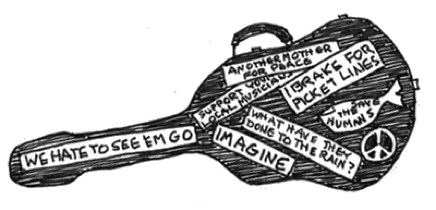


My
friend Kris gave me an odd present Monday at our memoir-writers group
meeting. Her father, a rock-ribbed Republican, had died and she had
found, in his effects, a little booklet of friendly advice to tea party
folks by David Horowitz called The Art of Political War for Tea Parties (2009).
She thought I might like to have it. She was right, as usual. The
author’s name rang a bell so I looked him up on the interwebs and sure
enough, he is also the author of Student: The Political Activities of the Berkeley Students
(Ballantine Books, 1962) which I had seen a copy of at the gathering
after the commemoration of the HUAC debacle. The man who brought the
book said Horowitz had written a good account of the HUAC demonstration
and the students involved back when he was a radical kid himself. He has
since become an active anti-communist and is now supporting reactionary
causes, including the tea-party movement. Student is hard to find now.
Horowitz is a red-diaper baby. Wikipedia provided this insight: “In a review of Horowitz's paean [Cracking of the Heart.
Regnery Press, 2009] to his daughter, Sarah, in which Horowitz explores
their estrangement and reconciliation, FrontPage Magazine associate
editor David Swindle wrote that Sarah—who cooked for the homeless, stood
vigil at San Quentin on nights when the state of California executed
prisoners, worked with autistic children in public schools, and with the
American Jewish World Service, helped rebuild homes in El Salvador
after a hurricane and traveled to India to oppose child labor—fused ‘the
painful lessons of her father's life with a mystical Judaism to
complete the task he never could: showing how the Left could save itself
from self-destruction.’”
Then
last night at the writing workshop led by Mary Webb, I got back my last
blog post which I had turned in, complete with photos, the week before
for her review. She noted that she had been in City Hall on the day
before, the day some anti-HUAC people got into the hearing room so there
was no protest inside, no washing students down the stairs, only the
picket line outside. She’d been busy elsewhere on Friday, to her regret.
The woman sitting next to me saw the photos and got curious. I showed
her what it was and she told me the paper she got back that night was
about Kent State, which had just (May 4) passed the fortieth anniversary
of the shooting of four students in an anti-war demonstration. So we
traded papers and started reading. She had missed the day as well—she
was enrolled at Kent State but was on a year of study abroad. However,
her sister was on campus that day, so I read a conversation between the
sisters about the events as seen from close up and far away. Their take
was that Kent State was a pretty non-political place in those days and
the police and administration over-reacted to actions by a small
minority of students.
So
what was in that booklet for tea-party activists? Mainly, that the
Democrats had been able to position themselves as the party of the
underdog, of women and minorities, and as Americans are a fair-minded
people, this always has appeal. Horowitz exhorts the Republicans to take
this position away from the Democrats, and indeed, that’s how the
tea-party people present themselves. Of course their presentation is a
little spoiled by the lack of minorities in their ranks.
And
a little PS to the “Bellybutton Test” post: “Corporations have neither
bodies to be punished, nor souls to be concerned, they therefore do as
they like.” —Edward Thurlow, British Lord Chancellor, 1731 -1806. And in
July 2009, at a lecture to the Stanford Business School, the CEO of
British Petroleum Tony Hayward explained to attendees that BP was going
in the wrong direction before he took over as CEO because, "we had too
many people that were working to save the world." (Thanks to Maureen
Barnato for that quote.)

If you live in California and are scratching your head over the propositions on the June ballot, here are recommendations from people I trust: The Ella Baker Center for Human Rights.

Nancy Schimmel
What
I forgot to say: Last night we watched Hollywood on Trial, a
documentary about HUAC hearings in Hollywood and DC targeting union
activists in the film industry. Claudia looked up the blacklist
afterwards in Wikipedia and found that "In 1941, producer Walt Disney
took out an ad in Variety, the industry trade magazine, declaring his
conviction that 'Communist agitation' was behind a cartoonists and
animators' strike. (According to historians Larry Ceplair and Steven
Englund, 'In actuality, the strike had resulted from Disney's
overbearing paternalism, high-handedness, and insensitivity'. Inspired
by Disney, California State Senator Jack Tenney, chairman of the state
legislature's Joint Fact-Finding Committee on Un-American Activities,
launched an investigation of 'Reds in movies'. The probe fell flat, and
was mocked in several Variety headlines." After the war, HUAC took up
this same tactic of trying to discredit active unionists as reds.
Unfortunately, in the atmosphere of the Cold War, they succeeded all too
well, and contributed to the decline in the power of unions leading to
today's sorry state.
Wednesday, May 26, 2010 - 11:49 AM
Anonymous
My
mother was an art/design graduate of a small Boston art school during
the depression. She learned to turn her skills to something that would
pay, eventually being offered a job at Twenthieth Century Fox. Her
friends who had moved to California to work for Disney simply told her
of his overbearing, driven insistence on overworking even the most
dedicated cartoonists....and not to venture into such territory...she
had to turn down the job due to family illness, but this just backs up
Nancy's point.
Wednesday, June 9, 2010 - 04:48 PM


Wednesday, May 26, 2010


DID THEY WASH YOU DOWN THE STAIR (part 2)





